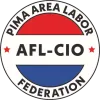How LGBTQ Union Activists Transformed the Labor Movement
As Pride Month is recognized around the world this year, the rainbow-hued celebration will be colored by hope, fear for the future, and reverence for the queer liberation movement’s radical past.
This year has already seen the murders of at least nine Black trans women in a slow-moving genocide that continues to ravage the community. The Trump administration is still forcing its agenda to deny basic human rights to queer people, especially those who are trans and non-binary. Around the world, queer people face brutal repression and inequality. Through it all, the community has stood strong, and even when faced with constant attacks by a homophobic, transphobic right-wing government, LGBTQIA people in the U.S. do have a formidable ally: labor unions.
American Federation of Labor and Congress of Industrial Organizations (AFL-CIO) President Richard Trumka noted in a 2018 op-ed, “For many LGBTQ Americans, a union card is their only form of employment protection,” and he’s right. There is currently no federal law that protects queer and trans workers from being discriminated against at work, and the Trump administration reversed an Obama-era policy that classified bias against trans workers as a form of sex discrimination, which falls under Title VII of the Civil Rights Act of 1964. With even that gone, queer and trans workers are left with no federal-level workplace protections, and are subject to individual states’ laws, which can also impact access to housing and health care.
